
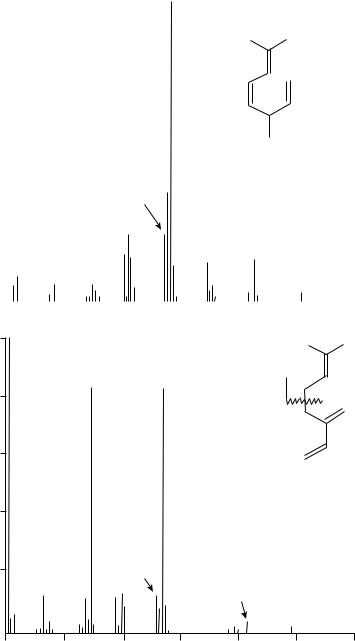
10. Analysis of dienes and polyenes and their structure determination |
491 |
(b) 100
|
80 |
Abundance |
60 |
|
|
Relative |
40 |
|
|
|
20 |
(c) 100
|
80 |
Abundance |
60 |
|
|
Relative |
40 |
|
|
|
20 |
93 (M-43)
|
|
|
|
|
|
|
|
|
|
(7) |
|
|
|
|
|
|
|
|
|
|
|
|
|
|
|
|
|
|
|
|
|
|
|
|
|
|
|
|
|
|
|
|
|
|
|
|
|
91 |
|
|
|
|
|
|
|
|
|
|
|
|
|
|
|
|
|
|
|
|
|
|
|
|
|
|
|
|
|
121 (M-15) |
|
|
|||
|
|
|
|
|
|
|
|
|
|
||||
|
|
|
|
|
|
|
|
|
|
136 (M+) |
|
|
|
|
|
|
|
|
|
|
|
|
|
|
|
|
|
|
|
|
|
|
|
|
|
|
|
|
|
|
|
40 |
60 |
80 |
100 |
120 |
140 |
160 |
|||||||
|
|
|
|
|
|
m/e |
|
|
|
|
|
|
|
41 |
|
|
|
|
|
|
|
|
|
|
|
|
|
|
|
69 |
|
|
93 |
|
|
|
|
|
|
|
|
|
|
|
|
|
|
|
|
|
|
69 |
|
|
|
(8)
91
121 (M-15)
136 (M+)
40 60 80 100 120 140 160 m/e
FIGURE 4. (continued)

492 |
Zeev Aizenshtat |
(11) |
(12) |
(13) |
+ |
• |
|
+ |
|
|
H |
H |
|
|
• |
+ |
• |
||
|
||||
|
|
|
H |
• +
(14)
Higher terpenes with diene and polyene moieties have also been investigated by mass spectrometry. However, we should be aware of the possibility that the molecular ion, such as that for C30H50 (Cn H2n 10) at m/z 410, may indicate, e.g., 6 unsaturated bonds or 5 rings and only one ene unit. A comparison of the MS of squalene and an unknown compound ‘X’ with an m/z 410 molecular ion is shown in Figure 5. The large ionized fragments down to m/z 299 may indicate similarity of the spectra, but the base peak for compound ‘X’ at m/z 191 indicates a hopene structure14. The use of this m/z 191 fragment for the identification of the hopanes and hopenes was reviewed extensively by Aizenshtat15.
Squalene is a unique natural product of a C30H50 structure with 6 non-conjugated double bonds. Hence, its MS shows a fragmentation pattern typical of non-conjugated
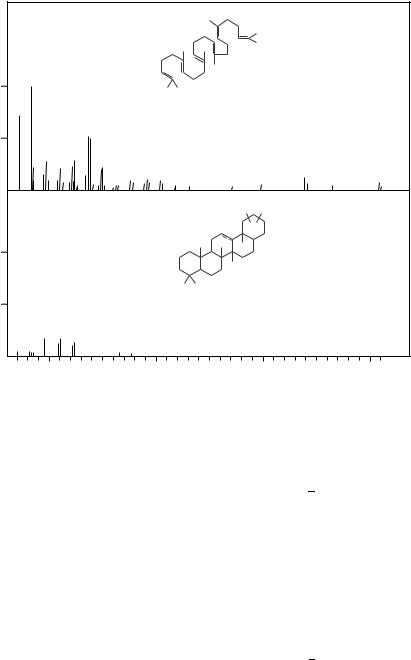
10. Analysis of dienes and polyenes and their structure determination |
493 |
100 |
81 |
|
|
|
|
69 |
|
|
50 |
|
|
Intensity |
95 |
109 |
Relative |
|
|
100 |
|
|
50 |
|
|
|
95 |
109 |
69 |
81 |
|
100
SQUALENE
C30H50
|
136 |
|
|
|
|
|
|
|
|
M-69 |
|
123 |
|
|
|
|
|
|
|
|
|
|
|
149 |
161 |
175 |
191 |
203 |
218 |
231 |
271 |
299 |
341 |
367 |
|
COMPOUND "X" |
|
|
|
|
|
|
|
||||
|
C30H50 |
|
|
|
|
|
|
|
|
|
|
|
|
|
|
191 |
|
|
|
|
|
|
|
123 |
136 |
149 |
161 |
175 |
|
204 |
218 |
299 |
|
341 |
367 |
|||||||
|
|
|||||||||||||||||
|
|
|||||||||||||||||
|
|
|
|
|||||||||||||||
|
|
|
|
|
|
|
|
|
||||||||||
|
|
|
|
|
|
|
|
|
|
|
|
|
|
|
|
|
|
|
|
|
|
|
|
|
|
200 |
|
300 |
|
|
|
|
|||||
|
|
|
|
|
|
|
|
|
|
|
m /e |
|
|
|
|
|||
M
410
|
|
M |
||
M-15 |
410 |
|||
395 |
||||
|
|
|||
|
|
|
|
|
|
|
|
|
|
400
FIGURE 5. Mass spectra of two C30H50 isomers. Squalene and hopene (compound X) are isolated from a sedimentary organic matter14,15
various polyenes and the base peak at m/z 81 and the abundant next peak at m/z 136 resemble the spectra of the terpenes discussed previously.
Polyunsaturated (dienes and trienes) lipids found in sediments have been proven to be valuable tools in the determination of palaeo-water temperatures6,16 18. These C20, C25 and C30 highly branched isoprenoids were investigated analytically by all the tools suggested in this review. We will select one diene to demonstrate the use of the MS, oxidation (bis-epoxidation) MS and 1H NMR techniques previously discussed. This diene, 2,6,10,14- tetramethyl-7-(3-methylpent-4-enyl)pentadec-5-ene (4), shows the fragmentation pattern given in Scheme 2.
Compound 4 was epoxidized to give 15 (Scheme 3) and the MS fragmentation of 15 is given by the broken-line m/z (relative abundance). To ensure the location of the double bonds, the epoxidation and the MS of 15 was compared with the products of the ozonolysis identified by GC and MS (as marked by the broken lines)6. The use of the various derivatization products via oxidation, combined with other spectroscopic methods, is discussed in Section III.
The MS studies of carotenoids have been reviewed previously19 21. Most carotenes show a molecular ion. Some carotenes with cyclic end moieties fragment to yield the tropylium ion (m/z 91) and some yield the m/z 105 xylene fragment. Specific deuteriation
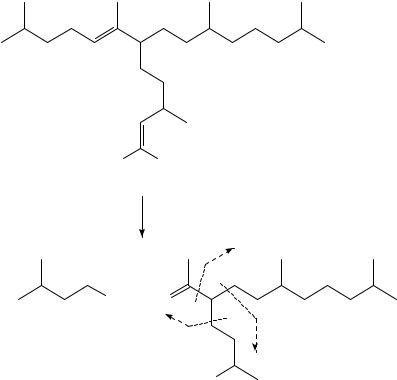
494 |
Zeev Aizenshtat |
H H
(4)
1.O3
2.Zn/H2 O
|
240 |
CHO + O |
+ H2 CO |
198
142 B-CO  114
114
A-H2 O  180
180
OHC
SCHEME 2
of the carotenoid structure helps in the MS assignments and facilities the structure determination. We should bear in mind that some of the carotenoids, e.g. Xanthomonas, have oxygen functional groups such as ketones, ethers and phenols and hence they show a different MS fragmentation patterns22. The halogenated substituent of Xanthomonas polyenes was identified first by MS and the bromine isotopic pattern was characterized23. Many ionization methods have been attempted for the studies of carotenoids. Among these, electron impact (EI) was the simplest and only the field desorption technique yielded useful results up to 199024.
Chemical and other physical methods of ionization were also employed for the structural determination of dienes and polyenes. Such is the case for the recent investigation of aliphatic dienes and trienes by chemical ionization with nitric oxide (NOC )25. It has been known since 1975 that olefins can be chemically ionized by NOC [CI(NO)]26. Two distinct processes may apparently occur: (i) electrophilic addition of NOC to the ene leading to [M C NO]C ion and (ii) an oxidative cleavage (possibly catalysed by the surface) R CHDCH R0 ! [RCO]C and/or [R0 CO]C . Budzikiewicz and coworkers25 do not have the answer as to which of the two processes dominate, but they have shown experimentally with a series of acetoxyalkadiene that both pathways (i) and (ii) depend on the reaction conditions. For alkadienes and a C10-triene carboxylic acid the position of the double bond can be easily determined if it is in a terminal position C1. However, if the double bonds are located somewhere in the middle of the carbon chain the ionization
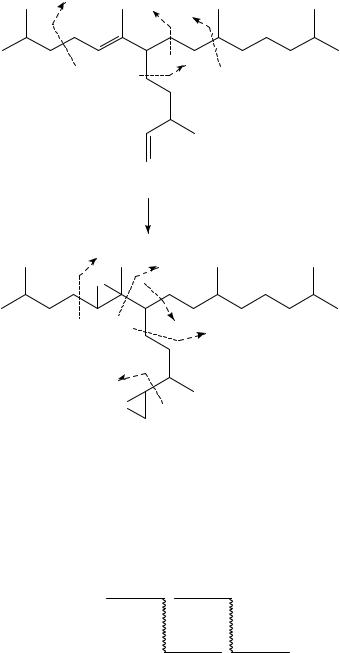
10. Analysis of dienes and polyenes and their structure determination |
495 |
292/1(2)
208/7(15) 235(10)
m•+ = 282
266(17)
(4)
epoxidation
309(3)
253(6)
O
239(15) 281(18)
100(43) O
(15)
SCHEME 3
by NOC yields an abundance of ions which make the determination of the location of the position quite difficult. Measurement of the chemical ionization (NOC ) spectra of the corresponding epoxides or collision activation studies can yield helpful data25.
Scheme 4, which is discussed in detail elsewhere25, is an example. If y D 0 we have a conjugated system; however, for y D 1 the ˇ-cleavage leads to a m/z 83 for x D 1 [CH3CH2CHDCH C O]C . This fragment is not always detectable.
[A]+ ;−H, +O [A ′]+ ;−H, +O
CH3 (CH2 )xCH=CH(CH2 )yCH=CH(CH2 )zR
[B]+ ;−H, +O [B′]+ ;−H, +O SCHEME 4

496 |
|
|
|
|
Zeev Aizenshtat |
|
|
|
|
|
|
|
|
|
|
|
|
|
||||||
TABLE 1. Relative abundancesa for PDPI/MS of hexadienes |
|
|
|
|
|
|
|
|
|
|
|
|
|
|||||||||||
Photoionization |
Compound |
|
|
|
|
|
|
|
|
|
Fragment (m/z) |
|
|
|
|
|
|
|
|
|
||||
energy (eV) |
|
|
|
|
|
|
|
|
|
|
|
|
|
|
|
|
|
|
|
|
|
|
|
|
|
CH3 |
C2H3 |
C2H5 |
C3H3 |
C3H5 |
C4H7 |
C5H5 |
C5H6 |
C5H7 |
|||||||||||||||
|
|
|||||||||||||||||||||||
|
|
(15) |
(27) |
(29) |
(39) |
(41) |
(55) |
(65) |
(66) |
(67) |
||||||||||||||
|
|
|
|
|
|
|
|
|
|
|
|
|
|
|
|
|
|
|
|
|
|
|
|
|
10.49 |
Hexa-1,3-diene |
27 |
6 |
1 |
30 |
19 |
|
|
b |
12 |
100 |
|
12c |
|||||||||||
|
|
|||||||||||||||||||||||
|
Hexa-1,4-diene |
24 |
48 |
24 |
100 |
41 |
20 |
11 |
89 |
|
|
d |
||||||||||||
|
|
|
|
|||||||||||||||||||||
|
Hexa-1,5-diene |
|
|
b |
|
|
b |
|
|
b |
100 |
77 |
|
|
b |
|
|
b |
|
|
b |
|
|
b |
|
|
|
|
|
|
|
|
|
|
|
|
|
|
|
|
|
|
|
|
8c |
||||
|
Hexa-2,4-diene 18 |
6 |
2 |
24 |
23 |
1 |
12 |
100 |
|
|||||||||||||||
9.68 |
Hexa-1,3-diene |
2 |
2 |
1 |
9 |
14 |
1 |
10 |
100 |
12 |
||||||||||||||
|
Hexa-1,4-diene |
2 |
3 |
11 |
38 |
55 |
28 |
16 |
100 |
|
4c |
|||||||||||||
|
Hexa-1,5-diene |
|
|
b |
|
|
b |
|
|
b |
32 |
100 |
|
|
b |
|
|
b |
|
|
b |
|
|
b |
|
|
|
|
|
|
|
|
|
|
|
|
|
|
|
|
|
|
|
|
|
|
|||
|
Hexa-2,4-diene |
4 |
3 |
1 |
12 |
22 |
2 |
14 |
100 |
19 |
||||||||||||||
a Relative to the most intense photo-dissociation peak; ionic fragmentation of the parent molecule is not included. b No peak observed; species is typically in less than 1 5% abundance.
c Corrected for photo-ionization background.
d All signals observed are from photo-ionization background.
In Section I the sensitivity of conjugated systems to possible photo-dissociation (PD) was mentioned. If this PD is conducted in the ionization chamber of a mass spectrometer, a PDPI/MS (photo-dissociation, photo-ionization/mass spectrometry) can be measured7. The examination of the PDPI/MS spectra of hexa-1,3-, 1,4-, 1,5- and 2,4-dienes using 9.68 and 10.49 eV photo-ionization (PI) is summarized in Table 1.
The fragments formed CH3 (m/z 15) up to C5H7 (m/z 67), are recorded by the MS and are semi-quantified. Since the photo-ionization leads first to ˇ-cleavage, the 1,3-diene leads to CH3ž and C5H7ž ; however, the ionization of the methyl radical is recorded only at 10.49 eV. Table 1 does not record the ionic parent molecule and fragmentation. It is seen that the data can be used to locate the double bonds of the diene. Whereas the ˇ-cleavage is the dominant PDPI/MS, rearrangement of fragments may also occur27.
VI. CHEMICAL DERIVATIZATIONS
To support the various spectroscopic methods for structure determination of dienes and polyenes we will mention some typical chemical reactions yielding derivatives that aid in the location of the double bonds, assign the cis or trans geometry and indicate whether these double bonds are conjugated. It is not our intention to review the chemical versatility of dienes and polyenes but rather to show some cases where the variation helps in the analysis.
Most methods used for analysis of alkenes, such as bromination and hydrogenation, can be employed to determine the number of double bonds in polyenes. These methods were also employed to classify various petroleums (‘bromine number’). However, these classical methods are employed less in analysis of conjugated dienes and polyenes mostly because the products produce a less informative mixture than in the alkene case.
Neumann and Khenkin28 review most of the various oxidation methods of dienes and polyenes and their mechanisms. They obviously emphasize the difference between nonconjugated and conjugated dienes and polyenes in selected oxidation reactions.
Conjugated dienes and polyenes lead to unique cases of conjugated oxidations, such as the formation of endoperoxide by singlet oxygen attack on the endo-diene, e.g. ˛- terpinene29.
For analysis of dienes and polyenes via oxidations one has to distinguish between the formation of an oxidized product of the target molecule (epoxide, peroxide, ozonide etc.) and the oxidative fragmentation of the molecule as in the case of ozonolysis30. Both
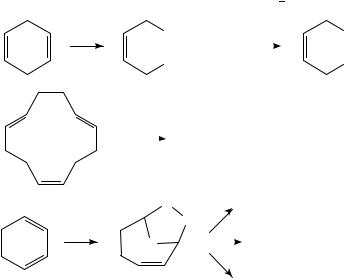
10. Analysis of dienes and polyenes and their structure determination |
497 |
approaches have been extensively reviewed, but mostly for mono-enes or for cases of independent/non-conjugated dienes and polyenes. Examination of the use of oxidative ozonolysis of natural rubber (polyene) and synthetic polyene polymers shows possible structure determination by GC analysis of the methyl esters of the acids formed (FAME method)30,31.
The use of both ‘ozonation’ and ‘ozonolysis’ is reviewed32. ‘Ozonation’ leads to ozonide and ‘ozonolysis’ leads to oxidized fragments, showing the use of both oxidative (AgNO3) or reductive [(CH3)2S or Ph3P] methods to produce the FAME (fatty acids methyl esters) that by subsequent GC analysis enabled determination of the position of the double bonds in the original molecule (equations 2 4).
COOH |
methylation |
COOCH3 |
O3 |
|
COOH |
|
|
|
|
|
|
|
|
|
|
|
|
(2) |
||||||
|
|
|
|
|
|
|
|
|
|
|
|
COOCH3 |
|||||||
7% |
|
|
|
|
|
|
|
|
|
|
|
|
|
|
|
|
|
|
|
1. O3 |
|
|
|
|
|
|
|
|
|
|
|
|
|
|
|
|
|
||
|
CH3 OOC(CH2 )2 CH |
|
|
|
|
|
CH(CH2 )2 CH |
|
CH(CH2 )2 COOCH3 |
||||||||||
|
|
|
|
|
|
|
|||||||||||||
|
|||||||||||||||||||
2. methylation |
|
|
|
|
|
|
|
|
|
|
|
|
(3) |
||||||
20% |
|
|
|
|
|
|
|
|
|
|
|
|
|
|
|||||
O |
a |
|
HOOC(CH2 )2 CH |
|
|
CHCOOH |
|||||||||||||
|
|
|
|||||||||||||||||
|
|
|
|||||||||||||||||
|
O |
|
|
|
O |
|
|
O |
|||||||||||
O |
|
|
b |
|
|
|
|
|
|
|
|
|
|
|
|||||
|
|
|
|
|
|
|
|
|
|||||||||||
|
|
|
HC(CH2 )2 CH |
|
|
CHCH |
|||||||||||||
|
|
|
|
||||||||||||||||
|
|
|
|
|
|||||||||||||||
|
|
|
|
c |
(4) |
||||||||||||||
|
|
|
|
|
|
|
|
|
|||||||||||
|
|
|
|
|
HO(CH2 )3 CH |
|
|
CHCH2 OH |
|||||||||||
|
|
|
|
|
|
||||||||||||||
|
|
|
|
|
|
|
|||||||||||||
a = Ag2 O
b = Ba(OH)2 /Acetone
c = NaBH4
The selectivity of the ozone reaction facilitates differentiation between conjugated bonds and isolated double bonds. Conjugated dienes form mono ozonide, which was claimed to inhibit reaction at the second double bond33. Hence, the yield of ozonolysis of one bond is much higher in 1,3-cyclohexadiene than in 1,4-cyclohexadiene and the same was found for other conjugated dienes33. Since the end products of the ozonolysis depend on the secondary treatment by the oxidation agents (Ag2O, H2O2, SeO2 etc.) or reducing agents [(CH3)2S, NaBH4, H2/Pd-CaCO3-PbO etc.], the chromatographic or spectroscopic identification must take into consideration the type of product.
A very important point to remember when using ozonolysis for structural investigation of polyenes is that the transoid bond is attacked preferentially34. Hence, the advantage of the ozonolysis in polymeric matter is obvious: the fragments formed are easier to analyse and they are also indicative of the double-bond positions (see Schemes 1 and 2).
In principle, all of the methods for selective oxidations of diand polyenes28 can be employed for analytical derivatization. However, the complexity of products obtained rules out some of these. Despite this, epoxidation of selected double bonds is used for comparison of spectra (see previous discussion on MS). Epoxidation of isolated non-conjugated
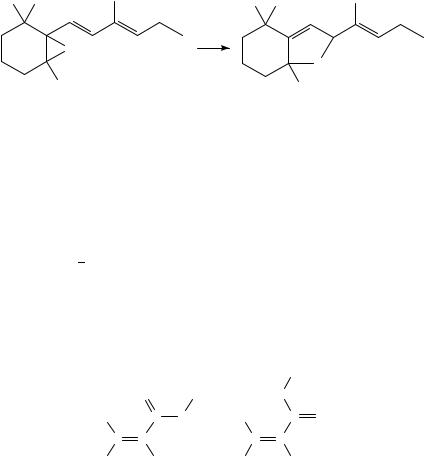
498 |
Zeev Aizenshtat |
double bonds is carried out mostly by peracids32. In recent works it is reported that metal oxides can catalyze hydrogen peroxide oxidation to form epoxides35. The bulk of the available information relates to epoxidation of non-conjugated double bonds. Some examples of the use of tert-butylhydroperoxide (TBHP) show that epoxidation increases with the increased nucleophilicity of the double bond and some spatial consideration must also control the regioselectivity. Conjugated dienes react slower and stepwise36. In carotenoids an ‘epoxide’ test was developed. The naturally occurring 5,6-epoxide (16) isomerizes under acidic catalysis to the 5,8-ether (17) leading to hypsochromic shift in the visible spectrum of the carotenoid50 (equation 5). This is a very interesting rearrangement that may indicate why epoxidation of conjugated polyenes yields a complex mixture. Therefore, it is recommended to use the epoxidation mostly in cases of non-conjugated dienes and polyenes.
6 |
O |
H+ |
|
8 |
(5) |
5 |
|
5 |
|
||
|
|
O |
|
||
|
|
|
|
|
|
|
(16) |
|
|
(17) |
|
In general, one can use a variety of oxidation techniques to form derivatives of dienes and higher polyenes for their analysis; however, the information obtained with conjugated systems is muddled by the complexity of products. Also, it is obvious that since the oxidized derivatives contain different functionalities, e.g. epoxides, alcohols, acids etc., the analytical techniques employed should also be variable (see also Scheme 2).
Whereas the classical reactions of dienes and polyenes are described in textbooks and in the present volume, some unique derivatives were suggested for structure elucidation. Such is the case with the synthesis of conjugated polyene carbonyl derivatives of the nitroxide spin-label 2,2,5,5-tetramethyl-1-oxypyrroline37. In particular, the exact conformation of an oxygen-containing functional group, such as that shown below, cannot be assigned by NMR. Conformational analyses have been carried out with the aim of understanding cis trans isomerization of the retinal38 and other biochemically interesting aldehydes, acids and esters with long conjugated unsaturated systems. These analyses included dipole moment measurements39, IR and microwave spectroscopy40, NMR41 and theoretical calculations. These techniques were found to possess insufficient sensitivity to assign precise molecular structures, in solution. In particular, even advanced 1H and 13C NMR methods cannot assign the protons of the s-cis and s-trans, and hence the exact conformation of the oxygen-containing functional group forms below.
|
|
|
R |
O |
R |
|
O |
H |
C O |
H |
C O |
C C |
|
C |
C |
H |
H |
H |
H |
s-cis |
|
s-trans |
|
An example is the structure of the derivative 18 formed by reacting the labelled oxypyrrolinyl with 2,4-pentadienal.

10. Analysis of dienes and polyenes and their structure determination |
499 |
||||
C |
C |
C |
|
C |
|
C |
C |
C |
O |
|
|
|
|
||||
C |
|
|
|
|
|
N |
C |
|
|
|
|
|
|
|
|
|
|
O |
|
(18) |
|
|
|
• |
|
|
|
|
|
As most of the nitroxyl spin-labelled synthetic derivatives of conjugated polyenes are light yellow crystals, the bond lengths were determined by X-ray crystallography38. The spectroscopic method used to measure the conformation is electron nuclear double resonance (ENDOR). It is beyond the scope of the present review to explain the method38 but the authors of the pertinent paper conclude that ENDOR is an accurate non-crystallographic method to determine polyene structures in solution.
Some derivatization methods mentioned in other sections of this review include chemical ionization by nitric oxide (MS) or epoxidation (MS), formation of -complexes for NMR (shift agents) etc. Also, the Diels Alder reaction, which was mentioned several times as a tool for derivatization of conjugated dienes and polyenes, was extensively described and reviewed in the literature.
VII. SELECTED EXAMPLES OF MULTI-PARAMETER ANALYSIS FOR DIENES AND POLYENES: STRUCTURE DETERMINATION
A. Enolic Dienes Derived from Testosterone-17b-acetate
Enolization of ˛,ˇ-unsaturated ketones, e.g. 19, under strong acid conditions leads to
a mixture of homoannular and heteroannular 2,4- and 4,6-dienes (e.g. 20 and 21; see equation 6)42.
OAc
O
(19) |
C3 F7 COOH |
|
(6) |
|
|
||
|
|
|
|
|
|
OAc |
OAc |
|
|
+ |
|
C3 F7COO |
|
C3 F7COO |
|
|
(20) |
|
(21) |
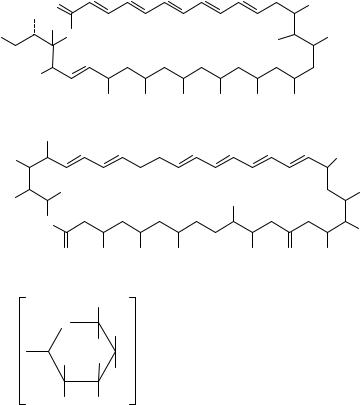
500 |
Zeev Aizenshtat |
The heteroannular diene is thermodynamically more stable and the UV spectra of the two dienes differ, as suggested by Woodward and Fieser’s rules5.
The heptafluorobutyrate derivative was selected for gas chromatographic separation, using electron capture detector (ECD), in order to enable the detection of ultramicro quantities43. The interest in the analysis of natural and synthetic hormones in very small concentrations enhanced the development of the GC method, in comparison with the UV study.44
B. Antiviral and Antifungal Mycoticin (A and B) Partial Structure
Determination
The natural products Mycoticin A (22, R D H) and B (22, R D Me) belong to the skipped-polyol-polyene class of antibiotics. Our analytical interest here is to use this very complex molecular structure to demonstrate some of the tools employed, mainly for the elucidation of the polyene part of the molecule. This family of ‘polyene macrolide class’ was discovered in 195045 with the finding of Nystatin (23), which is produced by the Streptomyces bacteria. The exact structure was elucidated only in 1970 by Chong and Rickards46 and, in 1971, Nystatin A1 (23) and A2 (not shown in this review) were separated.
O
Me
H
R O
Me
CH3
HO
CH3
H3 C
O
O
O
R =
OH
OH
Me OH
OH OH OH OH OH OH
(22)
OR
OH
OH
COOH
OH OH OH |
OH O |
OH |
(23)
CH3
H
H
NH2
OH
H H
